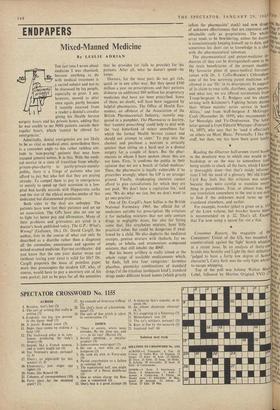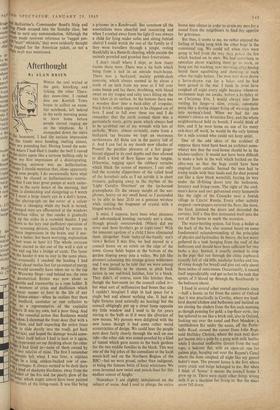ENDPAPERS
Mixed-Manned Medicine
By LESLIE ADRIAN
Admittedly, dental emergencies are not likely to be as vital as medical ones; nevertheless there is a consumer angle to this rather ruthless atti- tude to 'non-paying' patients that may have escaped general notice. It is this. With the medi- cal service in a state of transition from wholly- private-plus-charity to partly-private-mainly- public, there is a fringe of patients who can afford to pay but who feel that they are paying already. To compel them to pay in emergencies or merely to speed up their accession to a hos- pital bed hardly accords with Hippocratic oaths and the rest of the ethical mumbo-jumbo of this dedicated but discontented profession.
Both sides to the deal are unhappy. The patients have now lost their patience and set up an association. The GPs have also set one up to fight for better pay and allowances. Many of their problems and grievances are aired in a doctor's book published today, The G.P.: What's Wrong? (Gollancz, 18s.). Dr. David Cargill, the author, lists in the course of what can only be described as a diatribe rather than a diagnosis all the anomalies, annoyances and agonies of mixed-manned medicine. Eye-test certificates: did you know that the one your doctor wrote out (without testing your eyes) is valid for life? Dr. Cargill pinpoints the mass of pointless paper work that preoccupies the modern GP, who, of course, would have to pay a secretary out of his own pocket, just as he pays for all the amenities
that he provides (or fails to provide) for his patients. After all, what he doesn't spend-he keeps.
Doctors, for the most part, do not get rich, quick or in any other way. But they spend £100 million a year on prescriptions and their patients disburse an additional £60 million for proprietary medicines that have not been prescribed. Some of these, no doubt, will have been suggested by helpful pharmacists.. The Office of Health Eco- nomics, an offshoot of the Association of the British Pharmaceutical Industry, recently sug- gested in a pamphlet, The Pharmacist in Society, that 'counter prescribing' could help to deal with the 'vast hinterland of minor unwellness for which the formal Health Service cannot and should not attempt to cater.' To pop into the cheinist and purchase a nostrum is certainly quicker than sitting on a hard seat in a dismal surgery for a couple of hours. But the phar- macists to whom I have spoken about this are not keen. First, 'it confirms the public in their opinion that we are a bunch of failed medicos.' Then, the pharmacist is legally vulnerable if he prescribes wrongly, where the GP is on stronger ground. Finally, shopkeeping chemists cannot afford to give consultations for which they are not paid. 'We don't have a capitation fee,' said one. 'We do what we can, but we don't want to .go into practice.'
One of Dr. Cargill's Aunt Sallies is the British National Formulary 1963, the official list of medicines suitable for prescription. He criticises it for including mixtures that not only contain drugs in negligible doses, but also for listing some that, like strychnine mixture, have little practical value, but could be dangerous if swal- lowed by a child. He also deplores the mediwval receipts, gentian mixture with rhubarb, for ex- ample, or lobelia and stramonium compound mixture, that still inhabit the BNF.
But his heavy artillery is really aimed at the whole range of available medicaments which, he finds, fall into four categories: harmless placebos, gimmicky combinations of standard drugs ('of the tricolour toothpaste kind'), standard drugs under different brand names (which grossly inflate the pharmacists' stock) and new drugs of unknown effectiveness that are expensive and obtainable only as proprietaries. The whole array tends to be bewildering, unless the doctor is conscientiously keeping himself up to date, and sometimes his short cut to knowledge is a chat with the pharmaceutical salesman.
The pharmaceutical and patent-medicine in' dustries (if they can be distinguished) seem to be the main beneficiaries of the present muddle. My favourite piece of quasi-medical literature comes with Dr. J. Collis-Browne's ChlorodYne (one of the few surviving patent medicines still allowed to use 'Dr.' in its description). In support of its claim to treat colic, diarrhea, ague, spasms• and what not, we are offered testimonials from Troop-Sergeant A. E. Rodgers and his chums serving with Kitchener's Fighting ScOuts during their 'fifteen months' active service in South Africa,' and from Staff-Surgeon I. McGregor Croft (November 26, 1859), who recommends it for Neuralgia and Tic-Douloureux. The latest letter quoted is from Edward Whymper (February 16, 1897), who says that he 'used it effectively on others on Mont Blanc.' Personally, I like the stuff, but then, my tics have been quiet lately.
*
Reading the Observer half-crown travel books in the desultory way in which one would in bookshop or on the way to somewhere (and being unable to check all the facts, which I know is thoroughly done-but that's inside informa- tion) I felt the need of a glossary. My old friend Cyril Ray feels that this criticism was unjust because they were careful to translate every' thing in parentheses. True, or almost true, but one translation somewhere in the text is not easy to find if the unknown word turns up um' translated elsewhere, and earlier. For example, brochet (pike) is given on p. 113 of the Loire volume, but brochet beurre blafir is recommended on p. 22. That's all. Except that I'm now using a spoon for risi e bisi.
Consumer Reports, the magazine of the Consumers' Union of the US, has mounted 3 counter-attack against the 'light' Scotch whiskies in a recent issue. In an analysis of thirty-one brands into Scotchy and Light (by their definition 'judged to have a fairly low degree of Scotch character'), Cutty Sark was the only light whiskY to escape whipping. Top of the poll was. Johnny Walker Black Label, followed by Martins Original VVO en Ballantine's. Commander Bond's Haig and ZIA Pinch scraped into the Scotchy class, but 11.6d to earn any commendation. Although the Itttele made reverent reference to 'rugged pot- ittil"rnalt." whiskies,' they were evidently thought b0' rugged for the American palate, as not a liegle malt was mentioned.



































 Previous page
Previous page